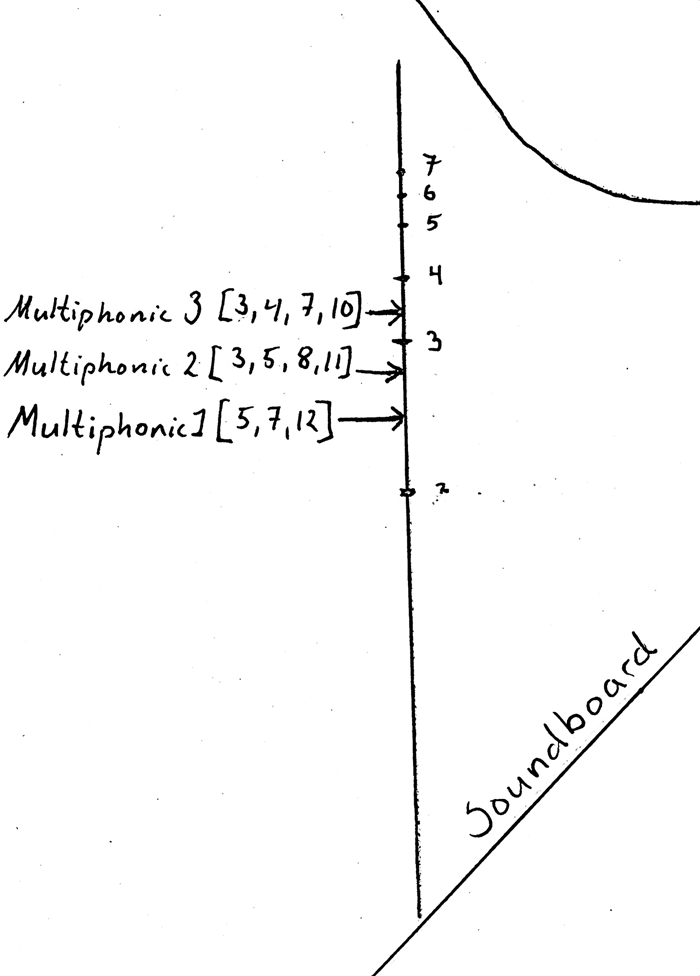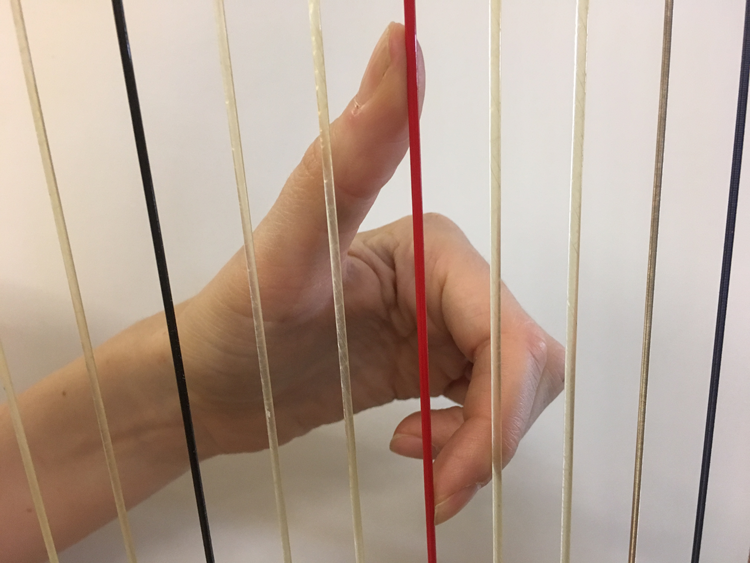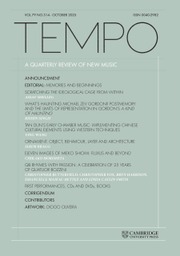Since the publication of my doctoral thesis and website www.harpnotation.com, in 2013, I have observed an increase in the usage of what I call extended harmonics – harmonics other than the octave harmonic. It is important, I think, to understand that, although the octave harmonic is a very standard harp technique, other harmonics are not. Despite this, extended harmonics have been in use since at least the 1960s.Footnote 1 The third harmonicFootnote 2 is mastered by most harpists, and is found in several standard repertoire pieces, but it is not considered a standard playing technique. Other harmonics – fourth, fifth, and in particular the sixth and seventh – are considered very experimental and are not commonly known in the repertoire or by harpists. These harmonics are much harder to produce than the octave and the third and more importantly they are considerably softer.
Consequently, I was very careful on my website when mentioning the higher harmonics, limiting myself to harmonics up to the 7th. Nevertheless, as I said above, I have observed an increase in the use of these extended harmonics. Unfortunately, composers still seem to overestimate their volume and underestimate their preparation time; and harpists often have trouble producing higher harmonics, as they are not aware of the alternate hand position needed. (See alternate hand position here: http://sites.siba.fi/web/harpnotation/other-partial-harmonics.) Since multiphonics are both harder to produce than high harmonics and much softer in volume I wondered whether their significance was theoretical rather than practical. I am still not sure; but it is a topic worth exploring, and in that spirit I share these initial observations made while sitting at my harp and experimenting.
Placement on the string
Multiphonics are groups of harmonics produced between the standard harmonic nodes on the string such that several harmonics are heard simultaneously. They are produced between harmonic nodes, for example, midway between the nodes of the octave harmonic and the 3rd harmonic. Several multiphonics can be found at almost the same spot; by only a small change of finger placement, the overtones heard are altered. It is easier to find multiphonics closer to the centre of the string, between the second and third harmonic nodes. The higher up (or down) the string you go, the smaller the space between each harmonic node gets, and the multiphonics get softer and more difficult to find.
A quite stable and reliable multiphonic can be found approximately midway between the second and third harmonic nodes. (I will call this Multiphonic 1 in this article) I recorded Multiphonic 1 on two separate strings, D@2 and G@1, and Ellen Fallowfield analysed the recording. She found that the 5th, 7th and 12th harmonics were present as well as the 19th. Multiphonic 1 is thus the 5,7,12 multiphonic also found at the same place of the string on the celloFootnote 3 and the guitar (Audio Files 1 and 2: Multiphonic 1 on the G@1 and D@2 strings).Footnote 4
Multiphonic 1 is relatively easy to find, owing to its position right between the octave harmonic and the third harmonic. I also think Multiphonic 1 is particularly practical since it corresponds very nicely with the 7th harmonic. This multiphonic has the 7th partial quite present. It is very nice to listen to the microtonal differences between the 7th harmonic (itself very overtone-rich) and the different components of Multiphonic 1 (Audio Files 3 and 4: Multiphonic 1 and 7th harmonic on G@1 and D@.2 strings).
Two other quite stable multiphonics can be found around the third harmonic: one slightly below the third harmonic and another slightly above the third harmonic. As with Multiphonic 1, I chose to look at and record these two multiphonics because they, too, are relatively easy to find. Most harpists know the placement of the third harmonic without marking the string; therefore one has a fixed reference point to orient towards. I also recorded these multiphonics on two different strings, D-flat 2 and G-flat 1. Multiphonic 2, found slightly below the third harmonic, turned out to be the 3, 5, 8, 11 multiphonic and in my sample the 19th harmonic was sometimes present as well (Audio Files 5 and 6: Multiphonic 2 on the G@1 and D@2 strings).
The analysis of Multiphonic 3, found slightly above the third harmonic, was not as clear. On the D@ string it was certainly the 3, 4, 7, 10 multiphonic, but on the G@ string, although 3, 7 and 10 were strongly present in the sound, the 4 was missing for some reason (Audio Files 7 and 8: Multiphonic 3 on the G@1 and D@2 strings).
More systematic research will perhaps reveal more about how register affects the results, but my initial observations (see Figure 1) show that the same multiphonics can be produced on different strings, and that their pitch follows the predictions of Caspar Johannes Walter's theory.Footnote 5

Figure 1: Multiphonic placements on string.
The higher harmonics, and the 6th and the 7th in particular, can almost be called multiphonics themselves since their sound is already quite coloured by other partials. I asked Ellen Fallowfield to analyse recordings of the 7th harmonic. Her analysis shows that the surrounding partials, i.e., the 6th and 8th are very present alongside the 7th. Also present are additions of these partials such as 6 + 7 = 13 for example, or 7 + 8 = 15. This is very normal on this part of the string since all the nodal points are very close together and it is very hard to isolate a pure harmonic.
This is especially true for the harmonics on the upper part of the string. The corresponding harmonics on the lower part of the string (close to the sounding board) tend to be cleaner and also to be louder. Perhaps the reason for this is the hand position. For the lower part of the string (close to the sounding board) one must use the thumb to stop the string and the second finger to pluck. (See further description below). I observed that the harmonic tends to be ‘cleaner’ if I use this hand position in the upper part of the string as well.
Hand position
When producing multiphonics (as well as higher partial harmonics) it is crucial to adopt a different hand position than the traditional harmonic playing position. It is important to obtain a sharp attack of the string and a precise stopping of the string. The stopping of the string has to be precise but not too firm. Traditionally, the left hand plays harmonics by stopping the string with the side of the hand and plucking with the thumb. To play multiphonics, however, it is advisable to stop the string with the side of the hand but pluck with the nail of the second finger. The second finger plucks the upper part of the stopped string (see Figure 2). Alternatively, one can stop the string with the thumb and pluck the string with the nail or fingertip of the second finger. Here the second finger plucks the lower part of the stopped string (see Figure 3). This technique is especially advisable when playing harmonics or multiphonics in the lower part of the string (closer to the sounding board).

Figure 2: Alternate hand position 1

Figure 3: Alternate hand position 2
Sound
Harp multiphonics are extremely soft and do not carry well. They are heard best very close to the instrument. To hear all the different components of the multiphonic amplification is recommended.
Predictability
The resulting sound is very dependent on accurate hand placement. Only the slightest shift in placement will result in a different balance of the harmonics heard. Even with a marking on the string it is very hard to reproduce the exact same multiphonic. It is perhaps worth pointing out that the harpist has no fixed reference points for producing harmonics, no fingerboard like the cello nor a fret to orient towards. The harpist has to mark the position on the string or memorise it in proportion to their instrument. To make matters even more complicated, the correct harmonic position varies according to the placement of the pedals. On the longer/lower strings in particular, this variation is considerable. Variations of pressure in the stopping hand and the force of the pluck also influence the balance of the multiphonic, as does the quality of the string with newer strings producing more overtones.
Range
Multiphonics are best produced on the wire strings of the harp.Footnote 6 The lower/thicker wire strings generally produce more overtones than the higher ones.
Bow
By bowing the string it is possible to obtain wonderful overtones and multiphonics (see, for example, Rhodri Davies playing OCCAM I by Eliane Radigue, www.youtube.com/watch?v=UMxSH9IvZn4).
Hairclips
Another way to produce complex sounds with multiple components is to prepare the strings with hair clips. This sound is audible and stable, and it can be produced quickly so it offers an attractive alternative to multiphonics. The resulting pitches cannot be predicted, however, since they depend on the placement of the clip as well as the material and the tightness of the clip.Footnote 7
Multiphonics are already being used on the harp. Caspar Johannes Walter has used them in several of his compositions, including Flatterecho 1 (2019) for harp and two cubic loudspeakers and Enharmonische Utopien II (2017) for harp and clarinet. In collaboration with harpist Alice Belugou, Walter is currently working on a large solo piece that will focus on multiphonics, extended harmonics and a specially developed scordatura system.
I am sure that harp multiphonics will spark interest amongst many composers in the future, but their delicacy and softness must be kept firmly in mind. I look forward to the heavily amplified solo piece that will play with their intriguing microtonality in combination with extended harmonics and other delicate sounds: I am already practising.




